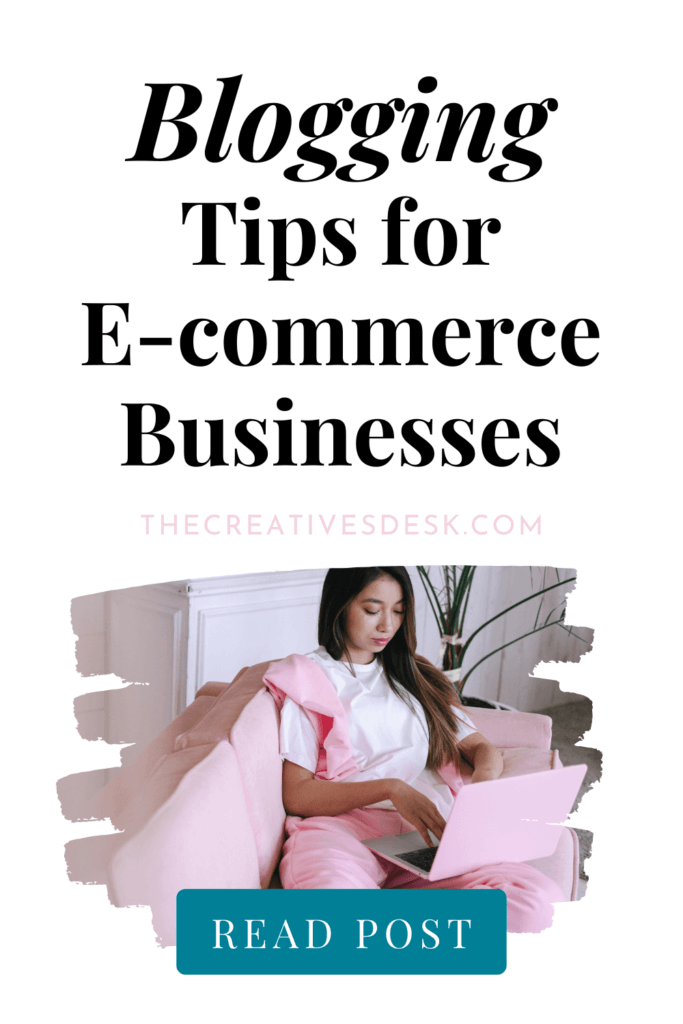

A quick search online shows that many e-commerce brand owners and marketers are asking,
“Should I add a blog to my e-commerce website?”
“Do blogs help e-commerce websites?”
“Is blogging to promote my shop worth it?”
And my super short answer is…
Yes! Blogging consistently helps showcase your products, attracts organic traffic, and builds a loyal customer audience for your store.
I have written hundreds of blog posts during my time working in digital marketing. For the company I worked for early in my career, I remember feeling excited seeing my efforts pay off as organic traffic from Google rose from around 2k unique visits a month to around 6k – all within four short months!
However, that was a few years ago and even though blogging and SEO has changed since then, I still recommend that your e-commerce business has a blog and that you regularly publish new blog posts.
Overall I think that blogging is a really important content marketing tool for e-commerce businesses.
If you create blog content that is valuable, informative and relevant to your audience, you can establish yourself as an expert in your field, drive more traffic, and ultimately make more sales!
In this post, you’ll discover the benefits of blogging for e-commerce businesses, tips for getting started and creating successful blog content.

My first e-commerce blogging tip for you is to make sure you get everything properly set up with your blog. Doing this helps ensure you’re successful with all your blogging efforts right from the start.
Make sure the blog section of your e-commerce website fits in with the rest of your site, and play around with the settings and theme to get it looking its best.
It’s a good idea to set specific measurable goals for your blog. This helps you stay focused and measure your progress.
Common blogging goals for e-commerce businesses include:
Identifying what you want to achieve, means you can tailor your content and strategies to meet these goals effectively.
Next, decide on some sort of posting schedule. Do you want to share a blog post weekly, once a fortnight, or every month? Make a plan and stick to it! Consistency is key to keeping your audience engaged and coming back for more.
Finally, make sure your blog posts are shareable directly from the page by including social media sharing widgets on your blog pages. This way, readers can easily share your content with their networks, helping you reach a wider audience without any extra effort on your part.
Right, after you’ve got everything ready the next thing to do is to create a blogging strategy…
As with any aspect of your business, jumping straight in without some sort of plan is rarely helpful. You need a strategy – a plan of action to help you get started and a structure to follow that you won’t deviate from.
Creating a well-thought-out blog strategy should form part of your overall e-commerce marketing strategy ensuring your efforts are focused and help you achieve your blogging goals effectively.
Make sure that your plan is achievable, even during your busier months. It’s better to publish a blog post just once a month rather than publishing two a week for a few months and then abandoning it for months on end.
Consistency builds trust and keeps your audience engaged, while erratic posting will lead to disengagement and a loss of readers.

Coming up with blog topic ideas can be difficult. To get started you might find it easier to write about what interests you, whilst at the same time considering your audience and what will interest them.
This will make it easier for you to start coming up with ideas, and you’ll be more engaged in the writing process.
There are a few different ways you can come up with topics that will both capture your readers’ attention and help you grow your blog traffic.
First, consider your target audience. What are they interested in? What do they want to learn more about in terms of your products?
Once you have a sense of what your potential customers are into and what they want to know more about, you can start brainstorming ideas for blog posts which will address those topics, answer their questions and keep them entertained.
Another way to get e-commerce blog post ideas is to look for trending topics online or find upcoming events related to your niche or industry; put together your own take on what’s happening, and turn it into a blog post.
Don’t be afraid of doing some competitor research too – just to find out what topics have previously worked well for others in your industry. I’m not saying plagiarise what other people have written, but it will give you a good idea of what areas to be looking at when it comes to writing blog posts for your business.
You can also repurpose your popular social media posts into long-form content; pad it out with quotes from others in the industry, statistics and more of your own opinions.
Here are a few examples of blog post types that work especially well for e-commerce stores:
If you need some blog topic ideas read my post which features a whole list of ideas for e-commerce blog posts.
You don’t have to be the best writer in the world.
You just need to ensure your blog posts are written to the best of your ability (or consider outsourcing) and that they make sense.
Run them through a spell-checker and, if possible, get someone else to read them before you publish them anywhere.
Separate big chunks of text using headings as this is great for SEO and for reader-friendliness.
SEO can help you drive traffic to a site, here are some tips to keep in mind when writing your blog posts:
Your blog isn’t just a platform for sharing updates or ‘how-to’ articles – you can also turn your blog posts into lead generation assets!
The best way to get leads from your posts is with strategic links to your offers that are essentially compelling call-to-actions (CTAs).
To make the most of your posts, your CTAs need to be thoughtfully placed, not just tacked on at the end.
Instead of relying on a single CTA at the bottom, weave them naturally throughout your content. Think: clickable in-text links, standout buttons, and bold, on-brand call-to-action banner graphics.
These are all ideal for promoting freebies, spotlighting products, or guiding readers to key content.
When done well, your blog becomes a lead-generating machine!

Here are two handy checklists I’ve created of things to do before and after publishing your new blog post to make sure it gets the attention it deserves.
Checklist 1 – before hitting publish:
Checklist 2 – after publishing a blog post:
Below, I’ve gone into some more detail on how to promote your new blog post on social media…

When you create great blog content, of course you’ll want to make sure as many people as possible see it.
One of the best ways to make sure of that is to regularly and consistently promote your content on social media.
Not only will this help you to reach a larger audience, but it can also help to increase traffic to your blog and store.
Keep reading to learn a few tips to maximize the impact of your blog post on social media…
Starting with a good hook, write engaging captions that highlight the value of your content, and post the link to the blog post wherever possible.
Use relevant hashtags to ensure your social media posts – and therefore your blog posts – are seen by as many people as possible.
Use eye-catching images in your social media posts to capture attention and help illustrate what the post is actually about. Studies show that blog posts with visuals get a whopping 94% more views, so this one is really important.
Utilize social media scheduling tools to strategically schedule posts at optimal times for maximum reach and engagement across different time zones.
Engagement is key on social media – so keep an eye on comments, replies, and shares, and ensure you respond to all comments.
Use Instagram stories, Facebook stories, and LinkedIn stories to provide additional context or behind-the-scenes insights about your blog post.
On your social media platforms, track metrics such as reach, engagement rates, click-through rates, and conversions. Use these insights to refine your content strategy, focusing on content types and posting times that generate the highest engagement and drive the most traffic to your blog.
Don’t miss this free resource download 👇
Free Social Media Captions & Ideas for Product-Based Businesses
Speaking of tracking metrics, don’t forget to check your website analytics to see how effective your blog posts are.
Pay special attention to page views and the average time spent on each page.
Make a note of which topics seem to be the most popular, and create more content based on those – as this is clearly what the people want to see!
You should be checking your analytics regularly (at least monthly) as these things do change. Create a spreadsheet to track all of your statistics if that’s the way you roll, or write them in pride of place on a big whiteboard wherever you do your laptop work.
What we’ve talked about in this post here should help you understand the basics of blogging for e-commerce businesses, and get you on the right track for creating your own content.
It doesn’t have to be difficult and you don’t need to be the world’s best writer – write about what you know, making sure it is clear and concise and not full of technical jargon. Your business will thank you for it.
As we’ve seen, creating quality blog posts can pay big dividends – you just need to get started!
Hopefully this blog post has inspired you to write your first one…

Share to…

Sign up to get 10 free Canva templates for your social media.
Created with solopreneurs in mind, these templates offer a variety of content types to help boost your online presence!